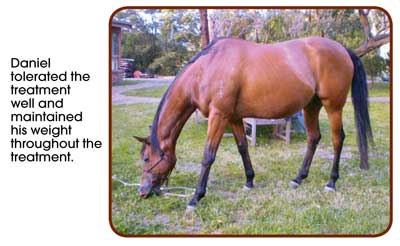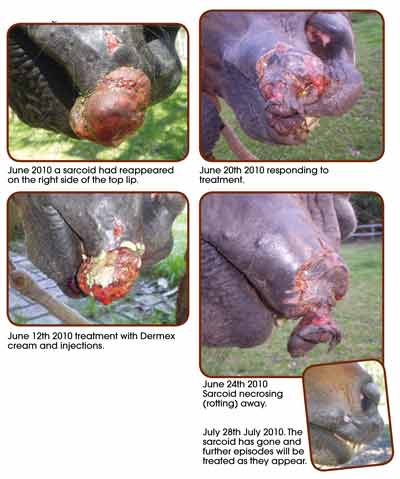|
Vol 34-3 Oct/Nov 2012
BEATING THE DEATH SENTENCE OF SARCOIDS
a reader's story by Cheryl McGaffin
Cheryl McGaffin, from the Mornington Peninsula in Victoria, purchased Daniel, a four year old Thoroughbred, 21 years ago. She planned to use the gelding, that was not long off the racetrack, as a general pleasure horse/adult riding club horse.
“He passed his vet check with flying colours, except for one small problem. Little did I know that years later, that small problem would rear its ugly head and threaten his very existence. That problem was a sarcoid,” she says.
Equine sarcoids are usually a benign, but problematic tumour if they choose to grow in places that interfere with a horse’s functional ability. They can be extremely difficult to treat, once that decision has been made, and for Daniel, treating this sarcoid was like opening up a can of worms; it resented interference and became insidious in its invasion of nearby healthy tissue, spreading underneath the skin in response to each treatment attempting to control it.
Fast-forward twenty-two years and the sarcoid that Daniel had when purchased, despite various treatment modalities along the way, had become twice the size of a grapefruit, a huge mass that was still spreading. Its original location was on the left side of his face above the upper lip, and it was barely noticeable, smaller than the size of a little fingernail.
Despite the best veterinary efforts, the tumour had now invaded most of the tissue on his nose and lip, and had spread to the side of his face, as well as inside the mouth. There was little to see on the surface, just a mass swelling of lumpy sinewy tissue in response to the tumour’s infiltration under the skin.
The sarcoid was unusual in how it looked. Originally it was best described as a piece of sinewy gristle that protruded from the side of Daniel’s upper lip. It developed over the years into a large mass that scared most people who saw it, as it looked a bit like the elephant man, (horse style) Cheryl thought. Most vets that had seen it over the years were uncertain as to whether it actually was a sarcoid!
For the first couple of years the sarcoid remained unchanged and Cheryl avoided biopsying it because that had been known to cause rapid growth of sarcoids. It was not causing any problems so the advice was to “leave it alone”. Then suddenly it started to get bigger and began to catch on bridles and halters. It bled when it was bumped or rubbed, and each time that happened, it grew larger.
On veterinary advice, it was treated with liquid nitrogen and frozen off . Cryotherapy, as it is known, is a fairly conventional treatment for sarcoids. This treatment appeared to work well, and for a few years it seemed all was well until suddenly, his nose became swollen and it looked like he had been bitten by a bull-ant. The swelling didn’t go down revealing the sarcoid had reactivated and was spreading underneath the skin.
It continued to invade adjacent tissues, and despite using conventional (and some alternative) methods of treatment, over the next few years its progress continued unabated so finally Cheryl had the tumour biopsied to see exactly what they were dealing with. It came back with a positive diagnosis of sarcoid.
LIFE SENTENCE
Despite the growth of the sarcoid, there were never any outward signs or indications that it was causing pain or discomfort and Daniel had no trouble eating, was in great condition and full of life. So veterinary consultations were continued to try and find options for treatment, however it was determined that the sarcoid had become too large and invasive, and there was no further treatment available. Cheryl was advised that the best course was to alleviate his symptoms and he was given three months to live.
Unable to accept that a happy and otherwise healthy horse in no pain would meet his maker in a few months Cheryl set about searching the internet to try and find something that would help.
TURTLE RESEARCH
Searching uncovered a report that had been published about a drug trial involving the treatment of tumours in green sea turtles in Hawaii in 2002. The turtles, considered to be a threatened species, had fibropapillomas and an experimental trial conducted under clinical conditions by a veterinarian and a marine biologist evaluated the use of the drug and its ability to remove the tumour non-surgically. “I was struck by the similarity of these tumours in appearance to those on my horse. The trial results showed the drug (called DERMEX) to be efficient at removing the tumour, without adverse effect on surrounding healthy tissue. The turtles also responded well to the treatment, gaining weight throughout the process,” said Cheryl, who then researched its use in Australia and found it had apparently never been used in this country before.
She contacted the authors of the report for additional information who then put her in contact with one of the inventors of the drug, Carl Hanson, a pharmacist from Centennial, Colorado in the US. He said that Dermex was being used by veterinarians in Colorado to treat equine sarcoids with great results and forwarded an email contact for a vet using the drug, Dr. Barbara Page of Colorado Equine Clinic, who had been using Dermex on equine sarcoids for the previous eight years. After seeing photos of Daniel and speaking with Cheryl, Dr Page said that, in her experience, Dermex had been the best treatment she had ever used on sarcoids. It was her professional opinion that, whilst Daniel’s sarcoid was very extensive and would be a challenge requiring several treatments, treatment with Dermex could only be of benefit.
It was reassuring that the drug was already being used for sarcoids, because this meant there were treatment protocols and guidelines already established to follow, which Dr. Page helped with. “This lessened any unease I may have felt had I been using a drug not previously used on horses. The primary classification for the drug is for human use, but as with all new drugs, trials are first conducted on animals, and if these are successful, progress to human trials (as is the case with Dermex),” says Cheryl.
Now she had the drug, protocols for use and thanks to the generosity of its inventor, a supply of the sample drug ready to be shipped for use in Australia. All Cheryl had to do was find a vet willing to participate in the pre-clinical trials of an experimental drug on her horse.
AUSTRALIAN TRIALS
In order to do that, Cheryl set about collating as much information as she could on Dermex and its use. After which she shopped around for a vet with an open mind and was fortunate to be recommended to Dr. Gary Stapleton, from WoofPurNay Veterinary Hospital in Narre Warren, Victoria who took the time to study the information and give the go ahead to start treating Daniel over the next twelve months.
TREATMENT
Much to both Cheryl and her vet’s relief, the drug got through customs without a hitch and the two, four weekly treatments were begun. Available in both an injectable and topical form, Dermex was applied topically and injected around the base of the sarcoid as well. The treatments were well tolerated by Daniel, with standing sedation used along with phenylbutazone after the procedure for three to four days. The most difficult part was with the topically applied cream, which has to maintain contact with the area to be treated for at least forty-five minutes - keeping the horse occupied and preventing it from rubbing the cream off was a challenge!
After each injection, the sarcoid became bigger, and eventually it burst through the skin and exposed itself in all its ugly glory. Things looked decidedly worse before they were to get better.
Cheryl’s nursing background helped her deal with the massive rotting tumour that was developing. It involved a lot of hands-on time, cleaning and debriding (removing the material) of the tumour as it necrosed (rotted) away and the many ‘cavities’ created by the rotting flesh had to be syringed and irrigated twice daily to prevent abscess formation.
When the sarcoid was injected, parts of it started to necrose within one to two days - these areas became cold to the touch and turned black; within one to two weeks, they could be sloughed away by hand.
Because the sarcoid was so extensive, getting to the base was proving to be difficult, so a decision was made mid way through treatment to surgically debulk it in order to gain better access. Once this was done the efficacy of the treatment increased.
Daniel was able to eat following each treatment, and in fact never missed a feed throughout, maintaining excellent condition. As the treatment has selective toxicity to cancer cells, it did not affect the surrounding healthy tissue. If Dermex is applied to healthy tissue, no reaction occurs, and in this way it is diagnostic for cancer cells.
COMPLICATIONS
Some of the complications incurred during treatment included an abscess formation (despite all that cleaning and debriding!), which was easily treated with drainage and antibiotics. Summer came and presented its own challenges with the flies, as the rotting flesh was particularly attractive to them, but a specially made extra large and well fitting fly veil along with repellent spray thankfully kept them at bay. Another complication was Daniel rubbing the topical ointment into his eye, which resulted in inflammation but thankfully no side effects. Cheryl f ound that putting a fly veil on after treatment was a must. ound that putting a fly veil on after treatment was a must.
COSTS
The costs incurred included those for veterinary visits, costs for sedation, drugs used and surgical debridement twice. The Dermex was supplied free of charge to Cheryl, thanks to Carl Hanson. Throughout treatment Daniel was on a supplement called Proflamm Aid Plus, which helped with wound healing. Because the sarcoid was so extensive, the edges of Daniel’s upper lip had to be sutured together in order to hold them in place whilst healing occurred. This enabled a good return of function, albeit with some scar formation and retraction of his upper lip.
OUTCOME
Whilst a fantastic result occurred, small sarcoids have reappeared, and these have been treated successfully with one to two treatments each over the last two years. They simply necrose and fall off over a two to three week period post injection and gradually, these return sarcoids have become less frequent.
Dr Gary Stapleton has now also used Dermex successfully on several other client’s horses with sarcoids, some of those in difficult to treat places such as near eyes, and also on dogs with inoperable tumours. It is too soon to tell whether or not Daniel will eventually become sarcoid free as a result of the use of Dermex, but given the original extensiveness of his sarcoid and its aggressiveness, Dermex has proven to be both a life saver and an alternative form of control.
Not all sarcoids react in this way, however by raising awareness of Dermex, Cheryl hopes this may help other horse owners faced with similar circumstances.
Cheryl extendeds her thanks to Dr. Gary Stapleton and his staff at WoofPurNay Veterinary Hospital for their dedication in treating this condition, and to Carl Hanson for his unwavering support and belief in a drug that has the potential for wide ranging oncological benefits and applications in not only the veterinary but human world as well.
Any queries about the use of Dermex can be directed to Dr. Gary Stapleton at WoofPurNay Veterinary Hospital www.woofpurnay.com.au /phone 0397968266
or contact Cheryl at email jasirooster1@bigpond.com
|